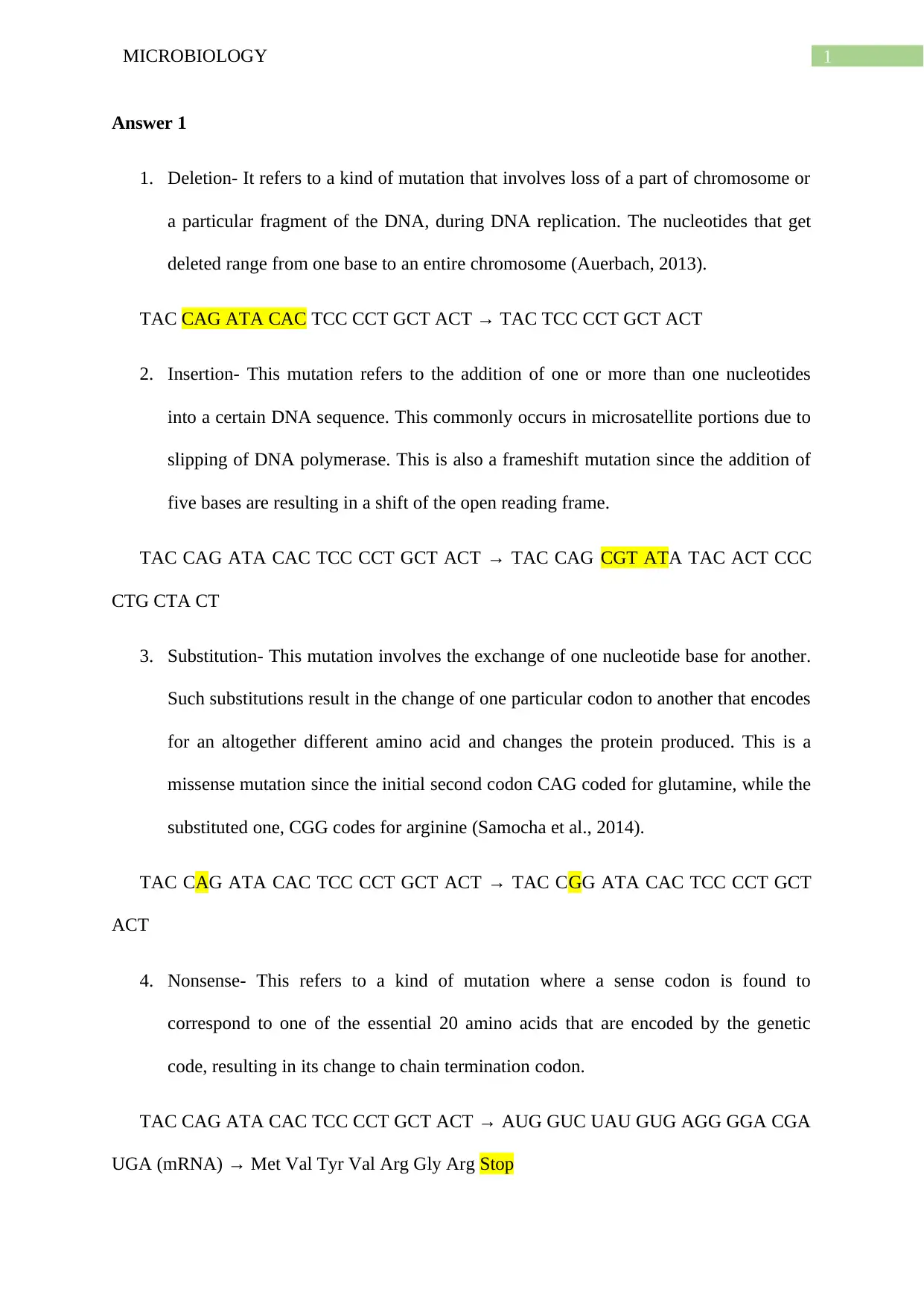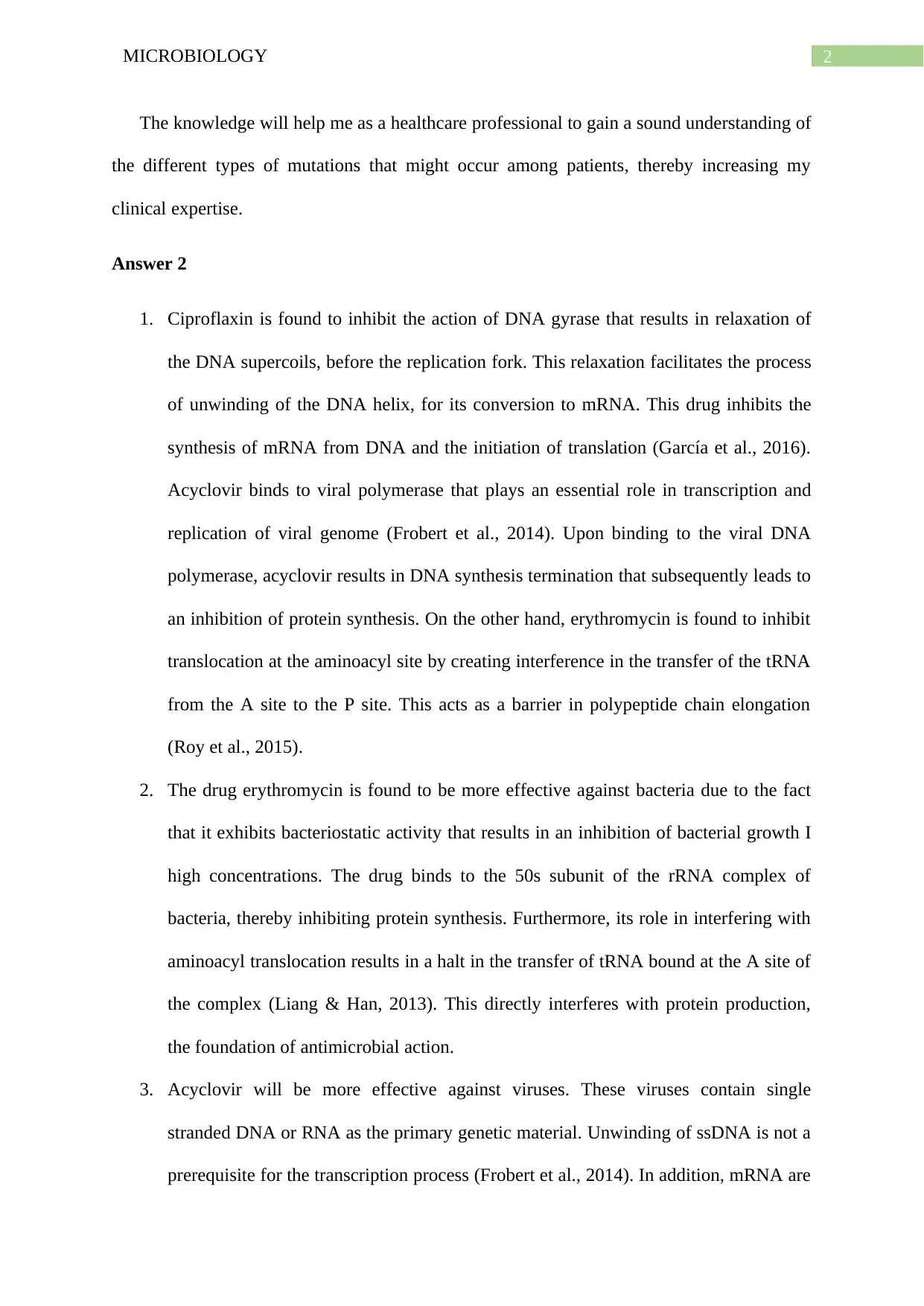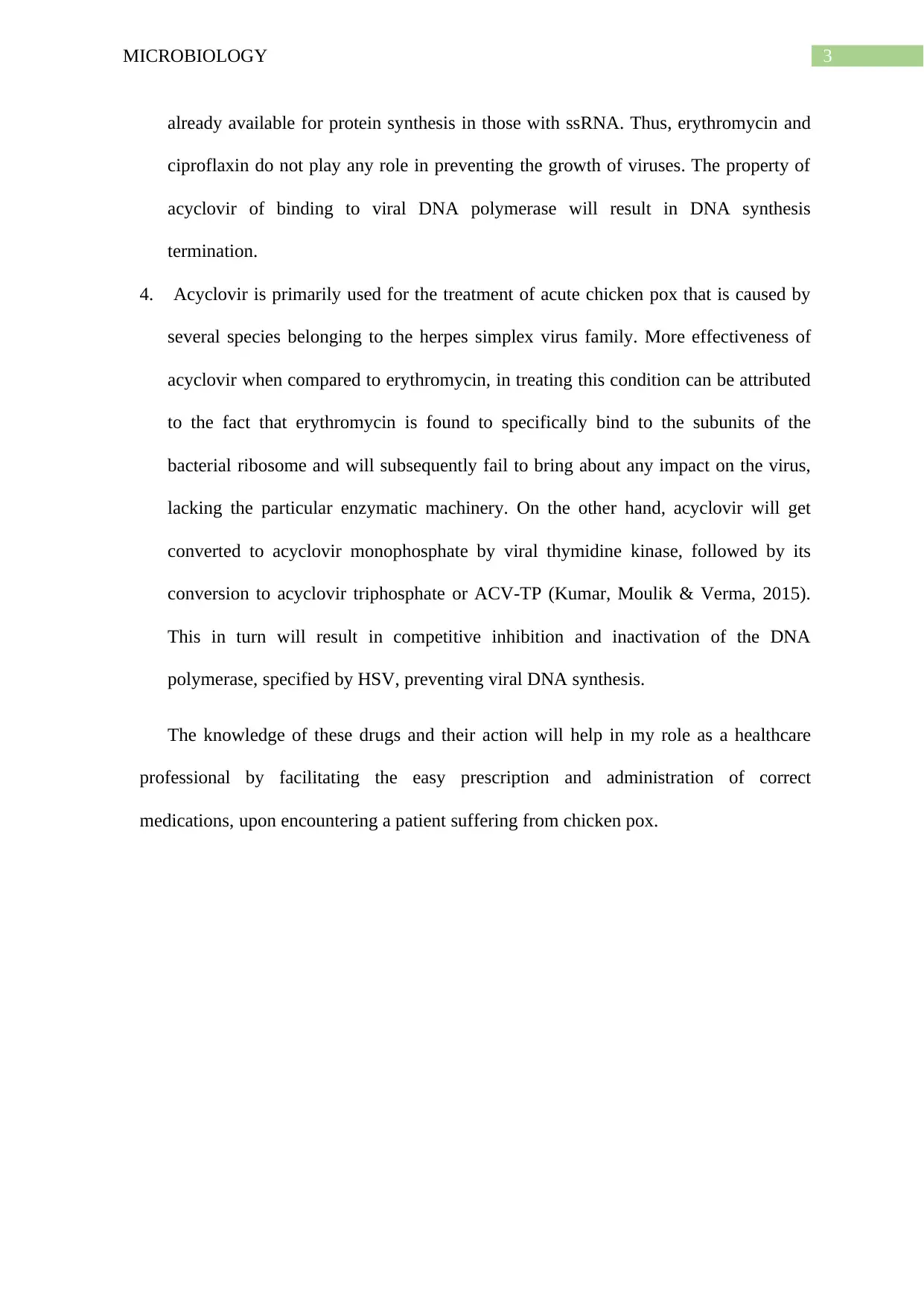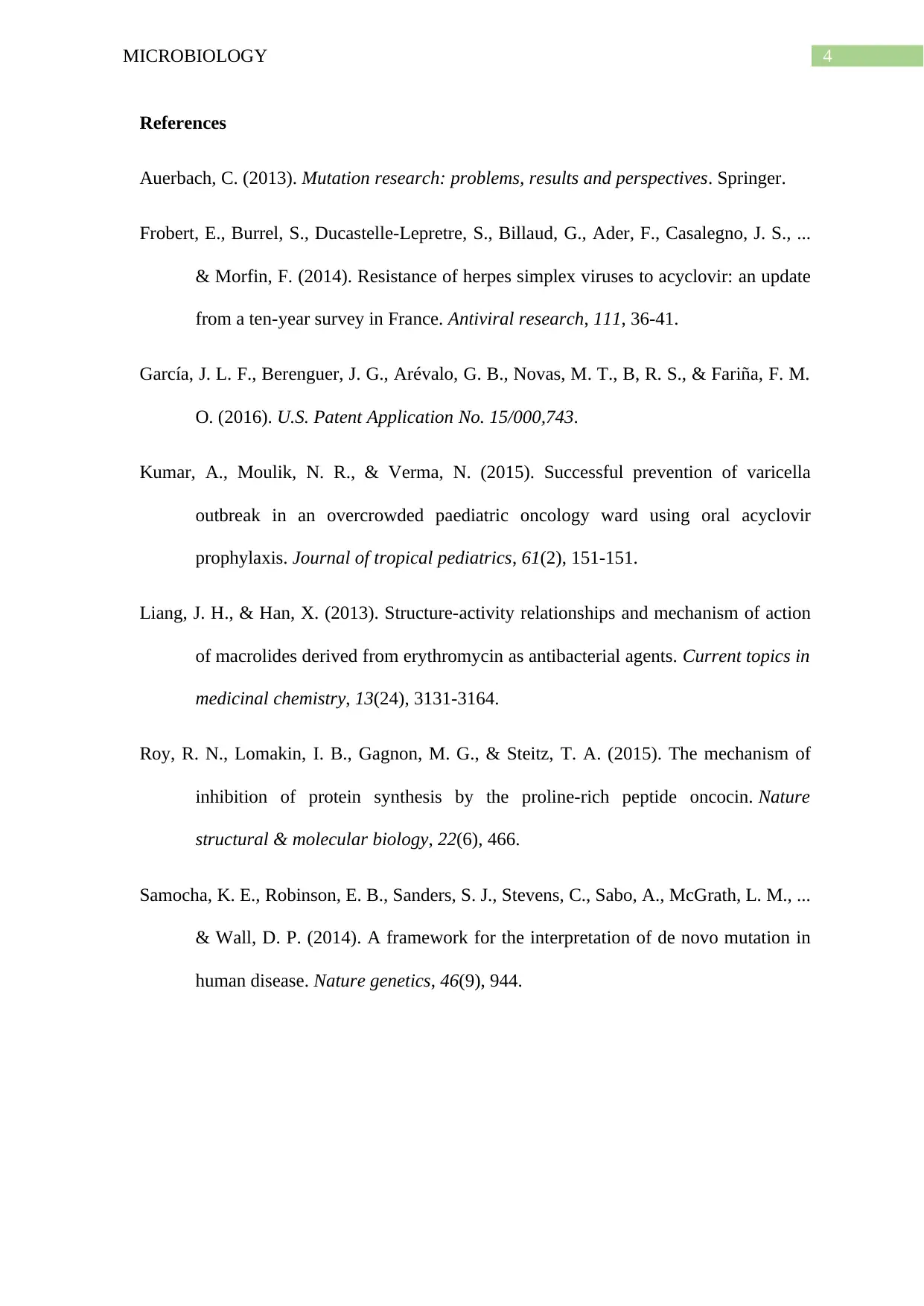Microbiology Homework: Mutations, Drug Mechanisms, and Treatment
VerifiedAdded on 2023/06/10
|5
|1217
|456
Homework Assignment
AI Summary
This microbiology assignment addresses key concepts including different types of mutations (deletion, insertion, substitution, and nonsense) and their impact on DNA sequences and protein synthesis. It explores the mechanisms of action of various drugs such as Ciprofloxacin, Acyclovir, and Erythromycin, detailing how they inhibit bacterial and viral processes. The assignment compares the effectiveness of these drugs against bacterial and viral infections, explaining why Acyclovir is more effective against viruses like herpes simplex. The student demonstrates an understanding of how this knowledge can be applied in healthcare to prescribe appropriate medications. The assignment emphasizes the importance of understanding drug mechanisms for effective treatment and patient care. The assignment also explains the role of these drugs and their effectiveness in the treatment of various diseases like chicken pox.

Running head: MICROBIOLOGY
Questions and Answers
Name of the Student
Name of the University
Author Note
Questions and Answers
Name of the Student
Name of the University
Author Note
Paraphrase This Document
Need a fresh take? Get an instant paraphrase of this document with our AI Paraphraser

1MICROBIOLOGY
Answer 1
1. Deletion- It refers to a kind of mutation that involves loss of a part of chromosome or
a particular fragment of the DNA, during DNA replication. The nucleotides that get
deleted range from one base to an entire chromosome (Auerbach, 2013).
TAC CAG ATA CAC TCC CCT GCT ACT → TAC TCC CCT GCT ACT
2. Insertion- This mutation refers to the addition of one or more than one nucleotides
into a certain DNA sequence. This commonly occurs in microsatellite portions due to
slipping of DNA polymerase. This is also a frameshift mutation since the addition of
five bases are resulting in a shift of the open reading frame.
TAC CAG ATA CAC TCC CCT GCT ACT → TAC CAG CGT ATA TAC ACT CCC
CTG CTA CT
3. Substitution- This mutation involves the exchange of one nucleotide base for another.
Such substitutions result in the change of one particular codon to another that encodes
for an altogether different amino acid and changes the protein produced. This is a
missense mutation since the initial second codon CAG coded for glutamine, while the
substituted one, CGG codes for arginine (Samocha et al., 2014).
TAC CAG ATA CAC TCC CCT GCT ACT → TAC CGG ATA CAC TCC CCT GCT
ACT
4. Nonsense- This refers to a kind of mutation where a sense codon is found to
correspond to one of the essential 20 amino acids that are encoded by the genetic
code, resulting in its change to chain termination codon.
TAC CAG ATA CAC TCC CCT GCT ACT → AUG GUC UAU GUG AGG GGA CGA
UGA (mRNA) → Met Val Tyr Val Arg Gly Arg Stop
Answer 1
1. Deletion- It refers to a kind of mutation that involves loss of a part of chromosome or
a particular fragment of the DNA, during DNA replication. The nucleotides that get
deleted range from one base to an entire chromosome (Auerbach, 2013).
TAC CAG ATA CAC TCC CCT GCT ACT → TAC TCC CCT GCT ACT
2. Insertion- This mutation refers to the addition of one or more than one nucleotides
into a certain DNA sequence. This commonly occurs in microsatellite portions due to
slipping of DNA polymerase. This is also a frameshift mutation since the addition of
five bases are resulting in a shift of the open reading frame.
TAC CAG ATA CAC TCC CCT GCT ACT → TAC CAG CGT ATA TAC ACT CCC
CTG CTA CT
3. Substitution- This mutation involves the exchange of one nucleotide base for another.
Such substitutions result in the change of one particular codon to another that encodes
for an altogether different amino acid and changes the protein produced. This is a
missense mutation since the initial second codon CAG coded for glutamine, while the
substituted one, CGG codes for arginine (Samocha et al., 2014).
TAC CAG ATA CAC TCC CCT GCT ACT → TAC CGG ATA CAC TCC CCT GCT
ACT
4. Nonsense- This refers to a kind of mutation where a sense codon is found to
correspond to one of the essential 20 amino acids that are encoded by the genetic
code, resulting in its change to chain termination codon.
TAC CAG ATA CAC TCC CCT GCT ACT → AUG GUC UAU GUG AGG GGA CGA
UGA (mRNA) → Met Val Tyr Val Arg Gly Arg Stop

2MICROBIOLOGY
The knowledge will help me as a healthcare professional to gain a sound understanding of
the different types of mutations that might occur among patients, thereby increasing my
clinical expertise.
Answer 2
1. Ciproflaxin is found to inhibit the action of DNA gyrase that results in relaxation of
the DNA supercoils, before the replication fork. This relaxation facilitates the process
of unwinding of the DNA helix, for its conversion to mRNA. This drug inhibits the
synthesis of mRNA from DNA and the initiation of translation (García et al., 2016).
Acyclovir binds to viral polymerase that plays an essential role in transcription and
replication of viral genome (Frobert et al., 2014). Upon binding to the viral DNA
polymerase, acyclovir results in DNA synthesis termination that subsequently leads to
an inhibition of protein synthesis. On the other hand, erythromycin is found to inhibit
translocation at the aminoacyl site by creating interference in the transfer of the tRNA
from the A site to the P site. This acts as a barrier in polypeptide chain elongation
(Roy et al., 2015).
2. The drug erythromycin is found to be more effective against bacteria due to the fact
that it exhibits bacteriostatic activity that results in an inhibition of bacterial growth I
high concentrations. The drug binds to the 50s subunit of the rRNA complex of
bacteria, thereby inhibiting protein synthesis. Furthermore, its role in interfering with
aminoacyl translocation results in a halt in the transfer of tRNA bound at the A site of
the complex (Liang & Han, 2013). This directly interferes with protein production,
the foundation of antimicrobial action.
3. Acyclovir will be more effective against viruses. These viruses contain single
stranded DNA or RNA as the primary genetic material. Unwinding of ssDNA is not a
prerequisite for the transcription process (Frobert et al., 2014). In addition, mRNA are
The knowledge will help me as a healthcare professional to gain a sound understanding of
the different types of mutations that might occur among patients, thereby increasing my
clinical expertise.
Answer 2
1. Ciproflaxin is found to inhibit the action of DNA gyrase that results in relaxation of
the DNA supercoils, before the replication fork. This relaxation facilitates the process
of unwinding of the DNA helix, for its conversion to mRNA. This drug inhibits the
synthesis of mRNA from DNA and the initiation of translation (García et al., 2016).
Acyclovir binds to viral polymerase that plays an essential role in transcription and
replication of viral genome (Frobert et al., 2014). Upon binding to the viral DNA
polymerase, acyclovir results in DNA synthesis termination that subsequently leads to
an inhibition of protein synthesis. On the other hand, erythromycin is found to inhibit
translocation at the aminoacyl site by creating interference in the transfer of the tRNA
from the A site to the P site. This acts as a barrier in polypeptide chain elongation
(Roy et al., 2015).
2. The drug erythromycin is found to be more effective against bacteria due to the fact
that it exhibits bacteriostatic activity that results in an inhibition of bacterial growth I
high concentrations. The drug binds to the 50s subunit of the rRNA complex of
bacteria, thereby inhibiting protein synthesis. Furthermore, its role in interfering with
aminoacyl translocation results in a halt in the transfer of tRNA bound at the A site of
the complex (Liang & Han, 2013). This directly interferes with protein production,
the foundation of antimicrobial action.
3. Acyclovir will be more effective against viruses. These viruses contain single
stranded DNA or RNA as the primary genetic material. Unwinding of ssDNA is not a
prerequisite for the transcription process (Frobert et al., 2014). In addition, mRNA are
⊘ This is a preview!⊘
Do you want full access?
Subscribe today to unlock all pages.

Trusted by 1+ million students worldwide

3MICROBIOLOGY
already available for protein synthesis in those with ssRNA. Thus, erythromycin and
ciproflaxin do not play any role in preventing the growth of viruses. The property of
acyclovir of binding to viral DNA polymerase will result in DNA synthesis
termination.
4. Acyclovir is primarily used for the treatment of acute chicken pox that is caused by
several species belonging to the herpes simplex virus family. More effectiveness of
acyclovir when compared to erythromycin, in treating this condition can be attributed
to the fact that erythromycin is found to specifically bind to the subunits of the
bacterial ribosome and will subsequently fail to bring about any impact on the virus,
lacking the particular enzymatic machinery. On the other hand, acyclovir will get
converted to acyclovir monophosphate by viral thymidine kinase, followed by its
conversion to acyclovir triphosphate or ACV-TP (Kumar, Moulik & Verma, 2015).
This in turn will result in competitive inhibition and inactivation of the DNA
polymerase, specified by HSV, preventing viral DNA synthesis.
The knowledge of these drugs and their action will help in my role as a healthcare
professional by facilitating the easy prescription and administration of correct
medications, upon encountering a patient suffering from chicken pox.
already available for protein synthesis in those with ssRNA. Thus, erythromycin and
ciproflaxin do not play any role in preventing the growth of viruses. The property of
acyclovir of binding to viral DNA polymerase will result in DNA synthesis
termination.
4. Acyclovir is primarily used for the treatment of acute chicken pox that is caused by
several species belonging to the herpes simplex virus family. More effectiveness of
acyclovir when compared to erythromycin, in treating this condition can be attributed
to the fact that erythromycin is found to specifically bind to the subunits of the
bacterial ribosome and will subsequently fail to bring about any impact on the virus,
lacking the particular enzymatic machinery. On the other hand, acyclovir will get
converted to acyclovir monophosphate by viral thymidine kinase, followed by its
conversion to acyclovir triphosphate or ACV-TP (Kumar, Moulik & Verma, 2015).
This in turn will result in competitive inhibition and inactivation of the DNA
polymerase, specified by HSV, preventing viral DNA synthesis.
The knowledge of these drugs and their action will help in my role as a healthcare
professional by facilitating the easy prescription and administration of correct
medications, upon encountering a patient suffering from chicken pox.
Paraphrase This Document
Need a fresh take? Get an instant paraphrase of this document with our AI Paraphraser

4MICROBIOLOGY
References
Auerbach, C. (2013). Mutation research: problems, results and perspectives. Springer.
Frobert, E., Burrel, S., Ducastelle-Lepretre, S., Billaud, G., Ader, F., Casalegno, J. S., ...
& Morfin, F. (2014). Resistance of herpes simplex viruses to acyclovir: an update
from a ten-year survey in France. Antiviral research, 111, 36-41.
García, J. L. F., Berenguer, J. G., Arévalo, G. B., Novas, M. T., B, R. S., & Fariña, F. M.
O. (2016). U.S. Patent Application No. 15/000,743.
Kumar, A., Moulik, N. R., & Verma, N. (2015). Successful prevention of varicella
outbreak in an overcrowded paediatric oncology ward using oral acyclovir
prophylaxis. Journal of tropical pediatrics, 61(2), 151-151.
Liang, J. H., & Han, X. (2013). Structure-activity relationships and mechanism of action
of macrolides derived from erythromycin as antibacterial agents. Current topics in
medicinal chemistry, 13(24), 3131-3164.
Roy, R. N., Lomakin, I. B., Gagnon, M. G., & Steitz, T. A. (2015). The mechanism of
inhibition of protein synthesis by the proline-rich peptide oncocin. Nature
structural & molecular biology, 22(6), 466.
Samocha, K. E., Robinson, E. B., Sanders, S. J., Stevens, C., Sabo, A., McGrath, L. M., ...
& Wall, D. P. (2014). A framework for the interpretation of de novo mutation in
human disease. Nature genetics, 46(9), 944.
References
Auerbach, C. (2013). Mutation research: problems, results and perspectives. Springer.
Frobert, E., Burrel, S., Ducastelle-Lepretre, S., Billaud, G., Ader, F., Casalegno, J. S., ...
& Morfin, F. (2014). Resistance of herpes simplex viruses to acyclovir: an update
from a ten-year survey in France. Antiviral research, 111, 36-41.
García, J. L. F., Berenguer, J. G., Arévalo, G. B., Novas, M. T., B, R. S., & Fariña, F. M.
O. (2016). U.S. Patent Application No. 15/000,743.
Kumar, A., Moulik, N. R., & Verma, N. (2015). Successful prevention of varicella
outbreak in an overcrowded paediatric oncology ward using oral acyclovir
prophylaxis. Journal of tropical pediatrics, 61(2), 151-151.
Liang, J. H., & Han, X. (2013). Structure-activity relationships and mechanism of action
of macrolides derived from erythromycin as antibacterial agents. Current topics in
medicinal chemistry, 13(24), 3131-3164.
Roy, R. N., Lomakin, I. B., Gagnon, M. G., & Steitz, T. A. (2015). The mechanism of
inhibition of protein synthesis by the proline-rich peptide oncocin. Nature
structural & molecular biology, 22(6), 466.
Samocha, K. E., Robinson, E. B., Sanders, S. J., Stevens, C., Sabo, A., McGrath, L. M., ...
& Wall, D. P. (2014). A framework for the interpretation of de novo mutation in
human disease. Nature genetics, 46(9), 944.
1 out of 5
Your All-in-One AI-Powered Toolkit for Academic Success.
+13062052269
info@desklib.com
Available 24*7 on WhatsApp / Email
![[object Object]](/_next/static/media/star-bottom.7253800d.svg)
Unlock your academic potential
Copyright © 2020–2025 A2Z Services. All Rights Reserved. Developed and managed by ZUCOL.